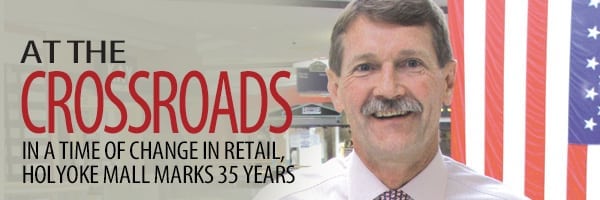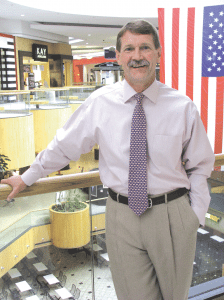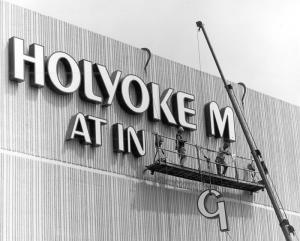
At the Crossroads
At a Time of Change in Retail, Holyoke Mall Marks 35 Years
When the Holyoke Mall opened in the Ingleside section of the city in 1979, shopping malls were the hottest trend in retail.These days, as the center celebrates its 35th anniversary, they’re anything but, losing ground to online retail options and smaller shopping centers. But Holyoke Mall remains a draw, said General Manager William Rogalski.
“Certainly, our traffic is good. In recent years, sales have fluctuated with the economy, but we’re still a significant part of people’s shopping experience,” he told BusinessWest. “Online shopping does affect us, but I’m still of the belief that people still like to see it, touch it, feel it, and try it on before they buy.”
To get shoppers inside the mall, though, variety and a fresh experience are key — part of the mall’s mission to get visitors to “stay longer and shop more,” to quote an oft-repeated mantra at Ingleside.
“We’ve always tried to be a shopping center where everyone can go, from the high end — like Apple, Sonoma, Pottery Barn, and a new store opening up, Michael Kors — to traditional retail tenants, to value tenants like Burlington Coat Factory and everything in between,” said Rogalski. “That’s what makes the difference for people here — there’s something for everyone.”
The fact is, despite the surge in online retail, consumers still visit brick-and-mortar stores for the vast majority of their shopping, according to a 2013 Nielsen report titled “Brick by Brick: The State of the Shopping Center.”
“Shopping centers aren’t just places to buy things,” the report notes. “They’re social centers, places for entertainment, and employment hubs. They’re also transforming what consumers can expect from a shopping experience.”
With the increasing diversification and aging of the U.S. population, the report continues, the line between shopping, entertainment, and community building has blurred, and this blending of experiences has created an opportunity for retail centers to strengthen social ties within communities that are looking for communal experiences.
“It’s a gathering point, even for people who don’t even shop, like mall walkers; for them, it’s a social experience,” Rogalski said. “And it’s nice to have them. Frankly, they’re a good source of information. They’re here every day, as we are, but we don’t see everything. In some cases, they become our eyes and ears. We’ve made some relationships, made some good friends.”
The goal of any mall, of course, is to ring up sales, and to that end, Rogalski — and Pyramid Management Group, which owns Holyoke Mall and 19 other properties in Massachusetts and New York — are not sitting on past laurels, instead moving forward with a series of renovations and possible future additions to keep the crowds coming back and spending money.
For this issue, Rogalski — a West Springfield native who actually worked at the just-opened Holyoke Mall in 1979, at Blake’s department store — sits down with BusinessWest to discuss some of those changes, and why he believes malls are far from irrelevant in the 21st century.
The Mall’s Changing Face
At its opening, Holyoke Mall was one of the largest shopping centers in the Northeast, with 125 stores covering 1.1 million square feet and surrounded by 5,000 parking spaces. Today, almost 200 stores (counting kiosks) sprawl across 1.6 million square feet of shopping space, and the construction of additional parking garages has expanded vehicle capacity to 7,052.But the mall still needed some work, said Rogalski, who has managed the facility for a dozen years. “We’re working on a major renovation now, retiling the whole center. We’re redoing the wood trim, replacing the wooden handrails with metal handrails, upgrading restrooms, and putting in a new guest-services area.”
Other changes will include refacing the mall’s signature glass elevator, new directional signage in the hallways, a continuation of energy-efficient lighting upgrades, new interior landscaping, and what’s known in the industry as ‘soft seating areas’ to help guests relax and extend their stay.
“It’s a pretty significant renovation. People will notice,” Rogalski said, adding that the work is largely taking place overnight so as not to disrupt shoppers. During BusinessWest’s visit, much of the the top floor had been torn out, awaiting new white tile, and fire alarms were being tested in the future location of Michael Kors.
He added that customer feedback has guided some of the changes, and mall management is also listening when it comes to future additions — including, perhaps, a movie theater. The Ingleside Eight Screen Cinema, which opened in 1979 and was located downstairs, beside the current food court, was shuttered in 1998.
“Of [Pyramid’s] 14 enclosed centers, we are one of two that does not have a movie theater. That’s definitely in the cards somewhere down the road for us,” he said, noting, however, that the mall is currently about 95% leased. “In one regard, that’s a good thing. But in another, it’s not so good, because we need to create space to include a movie theater. We’d be fine from a parking aspect; it’s a matter of getting contiguous space to do a theater.”
Pyramid is exploring other entertainment options as well, Rogalski added. “There’s always a buzz that gets created when we bring in new stores, restaurants, or entertainment. A lot of the changes happen gradually, but it’s always good to add new blood.”
Holyoke Mall, which attracts between 18 million and 19 million visitors a year, saw a downturn when the economy went south six years ago, but the hit wasn’t as severe as it was for retail centers in other regions.
“That’s probably more a reflection of Western Mass. as a whole as related to the general economy. Maybe because it’s our Yankee roots’ we’re a bit more conservative,” he noted. “When the nation is on a high, we don’t hit the high peaks; we roll a little bit below that. And when the nation hits lows, we roll a little bit above that; we skew more along the center line and don’t waver too far. That’s not to say we don’t have ups and downs, but they’re not as dramatic.”
Rather, the dramatic shifts come with the seasons, especially the holiday rush, from Thanksgiving through New Year’s Day, when many retailers find out whether they will turn a profit for the year.
“We’re in our second-best season now, back-to-school time,” Rogalski said. “Then we’ll have a little dip, accentuated by having the Big E for three weeks, drawing everyone’s attention. We certainly don’t shut down, but we feel the impact. Then we ramp up for the holidays. It’s a critical time, and it has been extended with the advent of gift cards — now it really flows into the end of December and the beginning of January.”
He added that malls tend to be slaves to the weather, citing a downturn in sales due to this year’s harsh, extended winter. “That impacted spring sales because people just weren’t in the mood. That’s one thing we can’t control.”
Gauging the Future
There’s plenty that malls can control, however, and it’s critical that they keep an eye on trends that have battered some shopping centers and helped others.
On the plus side for Holyoke Mall is its enviable location at the crossroads of two major interstates. While malls located away from highways have struggled in recent decades, Ingleside’s location draws shoppers from as far away as New York to the west, Hartford to the south, Worcester to the east, and Vermont and New Hampshire to the north. “We are at the intersection of 90 and 91,” Rogalski said. “Pyramid definitely paid attention to Marketing 101: location, location, location.”
America’s first enclosed mall, Southdale Center in Edina, Minn., was a true innovation in the way it invited people to browse, eat, hang out with friends, or just wander about. Early malls encouraged walking by placing anchor stores as far apart as possible, forcing visitors to pass dozens of small shops.
The model caught on big time, and the number of regional malls more than doubled from 1973 to 2006, topping 1,500 nationally, according to CoStar Realty Information. But since 2006, only one traditional enclosed mall has been built, in Salt Lake City. Analysts point to a number of factors hurting enclosed malls, from the growing popularity of smaller outdoor shopping centers to the rise in e-commerce.
But Pyramid has been proactive with freshening up a number of its properties, Rogalski said, including Walden Galleria near Buffalo, N.Y., Destiny USA in Syracuse, N.Y., Palisades Center in West Nyack, N.Y., and, of course, Ingleside.
Of course, no property that’s been around as long as Holyoke Mall will look much like it did 35 years ago, if only because the retail world is constantly in flux. Of the original 125 stores at Ingleside, only a few remain, including anchors JCPenney and Sears, as well as American Eagle Outfitters, Deb, Foot Locker, General Nutrition, Kay Jewelers, Motherhood Maternity, and Radio Shack.
Enclosed malls have been hurt by the decline of traditional anchors; Holyoke’s other two original anchors, G. Fox and Steiger’s, are long gone. But at the same time, the definition of an anchor has broadened significantly, and Holyoke Mall now boasts 12 anchors after launching with only four.
“We were probably the first developer out there that saw value in bringing in big-box retail,” Rogalski said. “Some said it can’t be done, that they want to be in strip locations, pad locations. But now you see the Targets, the Best Buys, you see Babies R Us, Hobby Lobby, AC Moore, those type of retailers. We thought they would be successful in a closed shopping center, and they’ve been wildly successful.
“Sometimes it takes retailers a while to think out of the box and get them out of their comfort zone,” he said. “But, at the end of the day, this is the Northeast; we aren’t sunny and 70 degrees 12 months of the year. It’s a nice convenience for shoppers to have all this under one roof.”
That kind of convenience, he said, will continue to make the Holyoke Mall a destination, especially given its prime location at the crossroads of the Pioneer Valley.
“It’s easy to get to, easy to park, easy to walk,” Rogalski said. “It definitely is an attraction.”
Joseph Bednar can be reached at [email protected]








